Several days ago, an article co-authored by the two1 crown princes of pro-Ukrainian military bad-takes, the preeminent Michael Kofman and Rob Lee, was published by Foreign Affairs. It seemed too good an opportunity to pass up in getting a look under the hood of the current narrative from the two chief propagandists themselves, and what was deemed so important as to warrant an urgent Foreign Affairs frontage.
Typically, when military or political ‘figures’ are ceded the floor to such a platform, it’s to make an urgent appeal for solidarity, a sort of think-tank-accelerated declaration to the world of their NATO devotees. And that’s what they’ve done; together, Kofman and Lee have rung alarm bills for the Western world to heed their words regarding the shifting outlook of the SMO and where things are headed.
The slant of their article converges with a theme now sweeping over Europe and the entire Ukrainian-supporting Western structure. It is that slow-gnawing realization that has been dawning on these Euro-apparatchiks like a cold sweat over the past several weeks: that Ukraine’s coming offensives will not prove decisive in any way; that Ukraine has no real chance in the present or short-term future. That the only way to move forward without sustaining an historically humiliating loss is to ‘kick the can down the road’ and focus on building a pro-war coalition for the future, one that can hope to match Russia’s long term military-economic sustainment potential.
And this is the general arc of Kofman-Lee’s desperate plea here. Couched in carefully mindful tones—so as not to cause too much panic or alarm amongst their decidedly fragile NAFO supporters—Kofman-Lee slowly build the case for why any sort of dramatic or decisive success should not be expected, and why instead the narrative needs to shift towards building long term sustainment infrastructure for Ukraine to be able to fight what is now likely to be a very long, drawn out conflict.
Ukraine is also eager to demonstrate that, despite months of brutal fighting, its military is not exhausted and remains able to break through Russian lines.
Indeed, what follows this operation could be another period of indeterminate fighting and attrition, but with reduced ammunition deliveries to Ukraine. This is already a long war, and it is likely to become protracted. History is an imperfect guide, but it suggests wars that endure for more than a year are likely to go on for at least several more and are exceedingly difficult to end. A Western theory of success must therefore prevent a situation in which the war drags on, but where Western countries are unable to provide Ukraine with a decisive advantage.
I’ve highlighted several times in recent articles how the narrative is beginning to swing towards this direction. Everywhere you look you’ll see Eurocrats and techno-fascist nomenklatura of the various Western states now conditioning their publics for accepting the inevitable indecisiveness of the coming offensive. We see this most of all in recent headlines urging for a focus on the future infrastructural buildup and sustainability of the war effort:
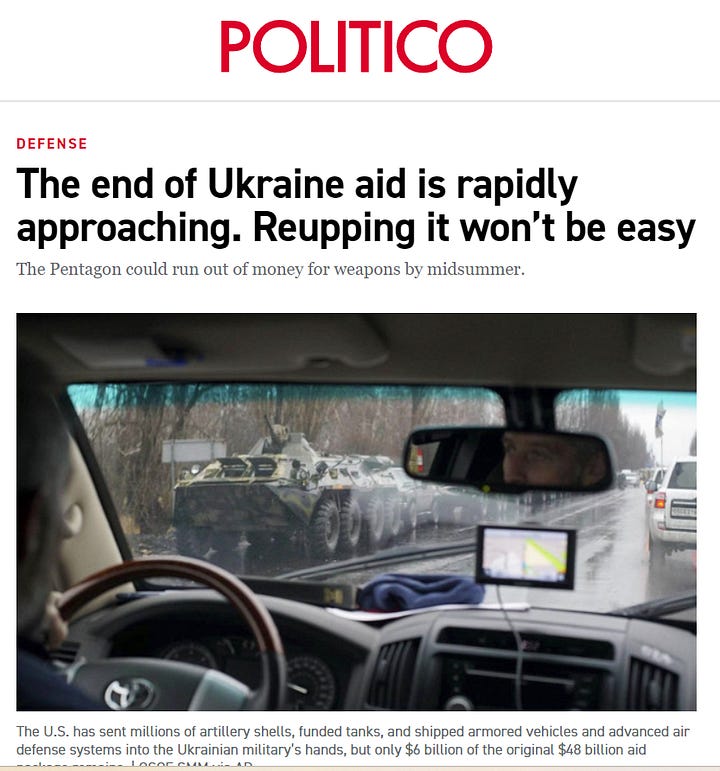

This Twitter thread by Dr. Snekotron highlights the problems.
He states that the U.S. will never truly ‘run out of money’ for supporting Ukraine, but…there are some important nuances:
There is a change in the nature of aid happening under the hood. There are two types of military assistance happening - PDA and USAI. The former is taking weapons out of US military stockpiles, while the latter is new orders. https://comptroller.defense.gov/Budget-Execution/pda_announcements/… https://comptroller.defense.gov/Budget-Execution/USAI_Announcements/
The vast majority of support thus far has been from Presidential Drawdown Authority (PDA), which is basically the U.S. sending Ukraine weapons from its own stock, rather than building new ones:
The vast majority of the packages have been PDAs culiminating in the huge packages in Jan., but since then PDA requests have scaled back and USAI orders increased substantially. The US wants to put this war on a sustainable footing in line with its own production.
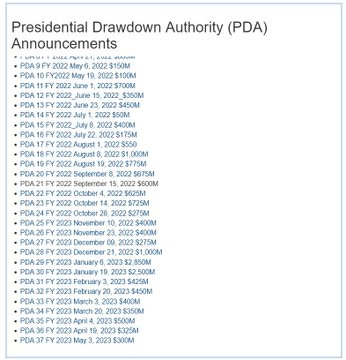
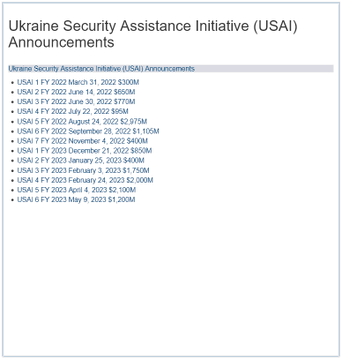
Clearly the US is growing wary of drawdowns of stockpiles of strategically relevant weapons. However, as you know if you've been following me, US production isn't really increasing much in the near future, which means the rate of equipment deliveries to Ukraine will be constrained.
He references the fact that there are no real substantial increases in production happening because actual production increase is extremely difficult, particularly in the currently volatile economic/market climate. So, Snekotron concludes that though U.S. may have ‘unlimited money’ in a sense, there will still be a major constraint in supplies to UA for the foreseeable future.
Western nations have given Ukraine a new lease on life by rebuilding its army from scratch at the cost of their own limited stockpiles. But now that those are drawn down and dried up, the path towards magically restructuring their limping economies into chuffing industrial powerhouses looks quite tenuous.
The dastardly disinfo duo appear to be making the case that, European leaders have merely splurged on their arms deliveries in the hopes of ‘washing their hands’, or giving the appearance of having helped to check off a box so as not to be ostracized, with the view that the coming offensive will settle everything and they won’t have to deal with the problem anymore. However, Kofman-Lee caution that this offensive will likely not create any incentive for ‘Putin to stop’ the war:
By placing too many bets on the outcome of this offensive, Western countries have not effectively signaled their commitment to a prolonged effort. If this operation proves to be the high point of Western assistance to Kyiv, then Moscow could assume that time is still on its side and that bedraggled Russian forces can eventually wear down the Ukrainian military. Whether Ukraine’s next operation is successful or not, Russia’s leader may have few incentives to negotiate. For Ukraine to sustain momentum—and pressure—Western states must make a set of commitments and plans for what follows this operation, rather than maintain a wait-and-see approach. Otherwise, the West risks creating a situation whereby Russian forces are able to recover, stabilize their lines, and try to retake the initiative.
Next, they ironically give Russia credit for having done exactly what they were supposed to do, the smart strategic maneuvers—which is in stark contradiction to what either one of them were saying at the time in public. Here they write that Russia’s orderly and ‘successful’ withdrawal from the right bank of Kherson allowed them to shorten their lines and concentrate manpower in a far more conducive way, which was obviously the point.
They go on to claim that Russia’s ‘winter offensives’ were a failure, but could only really list Ugledar as an example, once more reaching into the favored propaganda toolbag to claim that the Marines there received ‘thousands of casualties’ despite the fact that official casualty trackers registered very minimal losses during the entire period of the assault (low hundreds), and that the false narrative surrounding the Ugledar attacks hinged exclusively on a set of two or three short, misleadingly edited videos showing minor mishaps at the platoon level or lower.
When they turn to Bakhmut, they make a strange and nonsensical statement:
Moscow did not have the forces required to encircle Bakhmut, which could have led to a significant victory, so it instead focused on the more symbolic win of taking the city itself.
So, taking Bakhmut by encircling it would have been ‘significant’ yet taking the city “itself” is a downgrade? Why exactly? I suppose their failed argument would be: “Well, because by encircling the city, you could have trapped a large number of troops and destroyed them.” But what’s the difference? When Ukraine continued to pour in far more troops than they ever imagined having to utilize, the slow grind method actually resulted in far more losses to the AFU than even an ‘encirclement’ would have produced.
At any given time, the city only had maybe 20-30k troops inside of it at once, with more on the outskirts and outlying exurbs. By ‘encircling it’, Wagner could have potentially destroyed 15-25k, but instead, as Prigozhin has explained, they inflicted upwards of 50-60k casualties on the AFU, which was forced to stem an unending flow of losses by sending cannonfodder reinforcements, cheap throwaway ‘territorial defense’, over and over to the point where it had begun to shock even their Western supporters. During the worst of it, they admitted on Western television that the lifespan of a ‘meat’ soldier on the frontline of Bakhmut was around four hours or less. And several times, AFU officers admitted that their losses were typically two companies per day (400-500 troops).
In fact, just today a new report from a Western officer providing cover in Bakhmut said the following about Ukraine’s recent heroic ‘offensive’ attempts to unblock Bakhmut:
According to one of the NATO officers who provided headquarters support for counterattacks on the flanks of the Bakhmut group on May 12, Ukraine suffered one of the biggest losses since 2014 - 1,725 people were killed.
The strikes of the 2nd Azov brigade on the southern flank and two mechanized brigades and one motorized rifle battalion on the northern flank were stopped, and the losses amounted to one regiment.
The rapid withdrawal of Russian troops to the plain and the shelling of Russian tanks, artillery and Russian aircraft on the line of defense prepared at high altitudes led to heavy losses.
A large number of foreign mercenaries and far-right groups are stuck in Bakhmut. The Armed Forces of Ukraine have been trying for several days to ease the pressure on the group so that it can be withdrawn, but Russia nullifies these attempts with a massive bombardment.
In short, he states that an entire regiment was annihilated just so Zelensky could have his little two minutes of gloating on Western television that some insignificantly tiny corner of Bakhmut’s flank was ‘liberated’ for a few days.
Given the above, does one really think ‘encircling the city’ would have provided a more ‘significant victory’ than a six month grind fest which destroyed—as per many AFU soldiers’ own accounts—the very best of their personnel?
Kofman-Lee then make the following admission:
The majority of Russian casualties sustained in Bakhmut are from Wagner, and the majority of Wagner’s losses have been from minimally trained convicts. Those losses matter, but losing convicts affects Russia’s overall war effort much less than losing regular soldiers or mobilized personnel, especially outside settings like Bakhmut. Wagner convicts represent a minimal investment and are not individuals taken out of the economy, and so their losses lack political ramifications.
And finally, they come around to agreeing with my own view, circuitously, and actually contradicting their own earlier point about the quick encirclement of Bakhmut being a more ‘significant victory’:
But Ukraine may also find that the forces and ammunition it expended to defend Bakhmut, in relatively unfavorable terrain, will impose a constraint on operations later this year. Furthermore, Wagner’s assaults fixed a significant number of Ukrainian forces over the winter, giving the Russian military time to stabilize their lines and entrench.
Suddenly here they admit that the long grind may have critically depleted the AFU in not only manpower but materiel as well, for a questionable trade off of some convicts. Also, they’re implicitly agreeing with Prigozhin’s own stated take on the purpose of Bakhmut, which was to give Russian forces time to mobilize and train after September of last year when the mobilization was first announced.
Long term, the significance of the resources both sides expended in the battle will likely be the most important factor. Whether Ukraine could have pursued a better approach in this instance will be a subject for historians to debate.
Sure, Kofman-Lee. An obvious attempt to dissemble and cover their loss.
The next section is forward-looking. They attempt to evaluate UA’s chances in the coming offensives. Their opening statement does not give one confidence:
The challenge Ukraine faces is that, despite an influx of Western equipment, its force is largely mobilized, uneven in quality, and training on a compressed schedule. And over the course of the past year, the Ukrainian military has taken significant casualties. Many junior officers, noncommissioned officers, veteran soldiers, and troops previously trained by NATO have been lost in the fighting. This is a very short amount of time for newly mobilized soldiers to master new equipment and conduct combined-arms training as a unit.
Well, I’d say. This chart is a grim look on just how many of those officers Ukraine has lost.
Then comes a huge, if not comical, admission:
So: Ukraine was taught in “the NATO way”, BUT…apparently NATO is actually incapable of fighting without air superiority. Woops! Seems like that’s something which should’ve been noted up front to the poor AFU lab rats, no? The fact is, the entire ‘NATO training’ canard was a hoax perpetrated by cynical Western rulers for nearly a decade now. It’s been widely noted from the early parts of the Donbass war, 2014 and onward, by AFU soldiers themselves, that NATO trainers in fact were inferior to the Ukrainian troops they purported to be training. The reason is: their ‘knowledge’ is merely theoretical, and what one quickly learns on the battlefield is that nothing is comparable to the real life, firsthand experience of a blooded warrior, who has actually seen combat, not in the stuffy pages of a textbook, but in the grueling chaos of the trenches themselves.
This Saker interview with Dmitry Orlov for instance highlighted the fact:
And this 2017 article:
Which highlighted how NATO instructors were training Ukrainian fighters on weapon systems the instructors themselves had no clue how to load or handle. Photos showed NATO instructors incorrectly teaching AFU how to load DShK machineguns, not to mention with incorrect ammo types.
However, as one observant Ukrainian soldier pointed out, all the pictures actually served to prove was that the NATO 'experts' have no clue about how to handle the weapons used by the Ukrainian military.
As a result, following the instructional course conducted with the NATO instructors' help, Ukrainian machine gunners don't even know how to properly load their heavy machineguns' ammunition belts, says volunteer fighter Roman Donik.
But back to Kofman-Lee:
Nonetheless, the situation is less propitious for Ukrainian forces than it was in Kharkiv in September. Ukraine’s task is daunting. It must not only succeed, but must also avoid overextension.
Next, they discuss something which I wrote about in a recent report:
The challenge with the upcoming offensive is that, despite being saddled with high expectations, it appears to be a one-shot affair. Ukraine is likely to receive a substantial injection of artillery ammunition ahead of this operation, but this package will offer a window of opportunity rather than a sustained advantage.
I had mentioned how a ‘leak’ purported that Ukraine was allocated roughly a 10-14 day supply of munitions for any upcoming offensive. Recall that an offensive is a ramped-up ‘high intensity’ period where you typically fire off far more munitions than normal low intensity positional phases like much of the current phase. So if Ukraine is currently firing somewhere around 2-6k shells per day, they may be earmarked to fire 20k+ per day during the offensive. Which means for a hypothetical 14 day period, they may have something like ~300k shells prepared and stockpiled.
Kofman-Lee here are acknowledging this fact—that the offensive will be a limited ‘window’ of high sustainment, during which Ukraine is unlikely to achieve major decisive breakthroughs.
Indeed, Ukraine may be forced to fight with less artillery or air defense ammunition late this year than it was expending during the Russian winter offensive.
Here they acknowledge that after the AFU expends its load during the upcoming ‘offensive’, due to the ‘shortsightedness’ of Western partners’ supply goals, Ukraine may very well in fact be left with a much smaller allotment than they’ve had in the past half year or so. In short, the sustainment situation for Ukraine for the second half of 2023 may look patently dire.
In another eye-opening admission, Kofman-Lee note how focus on ‘gamechanging’ wunderwaffen has led to nothing but disappointment, as no one system is powerful enough to win a war entirely. The sad part is, any competent military strategist could have told you that even long before the war, but it was the pro-Western clowns who insisted on deluding themselves with such crass fantasies.
Yet what has remained constant is that analysts and policymakers who believe that the next weapon system sent to Ukraine would prove to be a game-changer have consistently been disappointed. Conventional wars on this scale require large numbers of equipment and munitions and scaled-up training programs. Capability matters, but there are no silver bullets.
After doing so well for the length of the article, actually making starkly honest realizations and acknowledgments for the first time in their grift-careers, they end on a typically offkey note. It’s understandable, of course, after presenting such a pessimistic image to their walleyed and wooly followers they were inclined to throw them a charitable pick-me-up, so as not to kill their hopes entirely.
So they perorate with this misleading CNN-level boilerplate:
That said, Russia does not seem well positioned for a forever war. Russia’s ability to repair and restore equipment from storage appears so constrained that the country is increasingly reliant on Soviet gear from the 1950s and 1960s to fill out mobilized regiments. As Ukraine acquires better Western equipment, the Russian military has increasingly come to resemble an early Cold War–period museum.
Funny that they mention that. Just yesterday, Russian deputy prime minister and minister of trade and industry Denis Manturov reported the following updates:
More tanks were produced in the first quarter of 2023 than in the whole of 2022.
There are 7 times more weapons fired than in 2022.
The total volume of military production will increase by 4 times in 2023.
This is in addition to the previously reported figures from Rostec CEO Chemezov that Russia has produced 300+ helicopters in the first few months of this year, compared to ~150 for all of last year.
Extrapolating, Russia had previously manufactured upwards of 150-250 tanks per year, with Medvedev promising to upscale this to 1600+. Though this number includes refurbished and upgraded tanks, which actually make up the bulk, it’s still indicative of vast industrial outputs. Manturov’s new figures shed some light on this. It’s unclear if he’s referring to only newly manufactured, or the total which includes refurbs and upgrades as well, but it certainly points to a colossal number that is likely well beyond anything such small-minded incompetents as Kofman-Lee are capable of acknowledging.
The fact of the matter is, the ‘West’, powered by the propaganda churning mill of inept ‘analysts’ like the above, will be in for a massive shock and rude awakening when they begin to see the effects of Russia’s unprecedented economic up-scaling actually percolating down to the battlefield. It remains unseen for now only because Russia continues to lie in wait, like a panther in the savannah brush, for the right opportunity to strike. But if these faulty premises are what the West chooses to continue operating under for their understanding of the battlefield dynamic, then the future will be riddled with cognitive dissonances and finger pointing the likes of which we can hardly imagine. It’s only to Ukraine and the West’s detriment that they so desperately downplay and attempt to whitewash Russia’s unprecedented industrial revitalization.
As it stands, what follows the coming offensive will reveal whether Western countries are arming Ukraine to help Kyiv fully restore territorial control or just to put it in a better position for negotiations.
I think we all know the answer to the above.
Their final send off is a last urgent plea for Western powers to “think beyond” the offensive, and instead focus on supporting Ukraine to the hereafter:
How quickly things have shifted. Recall, just earlier this year, the narrative was that the coming post-Winter offensive would ‘break’ Russia, and be the final blow to end the war. Myriad MSM headlines spun us a tale of Russia on its last legs, Putin ‘on the ropes’ and awaiting the knockout punch. Too bad they failed to inform their audience that Putin was merely imitating Ali in Zaire, when Foreman, too, was overeager to finish off his putatively rope-slung opponent.
In fact, Ukrainian officials were falling over themselves to announce that the “war would be over” this summer, or even by May.

Now, suddenly the tone is changing. The Western MICs are scrambling for ‘sustainment’ options and long term survival strategies, morale erosion mitigation measures, etc. As I said, it’s likely that many European countries are merely doing their token share to ‘wash their hands’ of the conflict, so as not to be accused of disloyalty to the Euro-Technocrat-Globalist order. In reality, that bare minimum is just good enough to give Ukraine one last hurrah of the television highlight reel, where they hope to gain a single major piece of psychological leverage over Russia for use in the ensuing negotiations. The most likely target for that can only logically be the ZNPP nuclear power plant in Energodar.
Today alone, Russian MOD has announced the shoot down of six total Storm Shadow missiles, so that wunderwaffen many were counting on to herald a ‘game changing’ destruction of Kerch bridge from afar, has already been relegated to the same dustbin of mediocre accomplishment that the Javelin and HIMARs currently keeps warm.
The only final hope that the EU/UA have is the blind prayer that Russia’s seeming inactivity and focus on Bakhmut alone for the past few months were telltale signs of worn-down inability and force exhaustion, rather than the patient buildup it clearly represents. Ukraine will fatally gamble on the notion that Russia has and will continue to “pull back” until some negotiated settlement favorable to Ukraine will ultimately be ironed out.
It’s too bad they don’t see the ‘pull back’ for what it really is:
If you enjoyed the read, I would greatly appreciate if you subscribed to a monthly/yearly pledge to support my work, so that I may continue providing you with detailed, incisive reports like this one.
Alternatively, you can tip here: Tip Jar


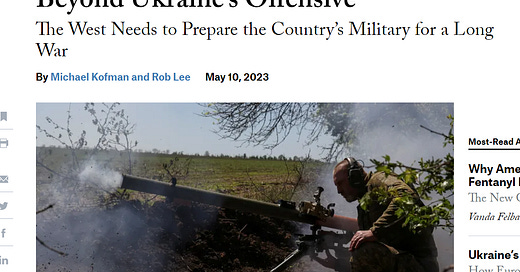




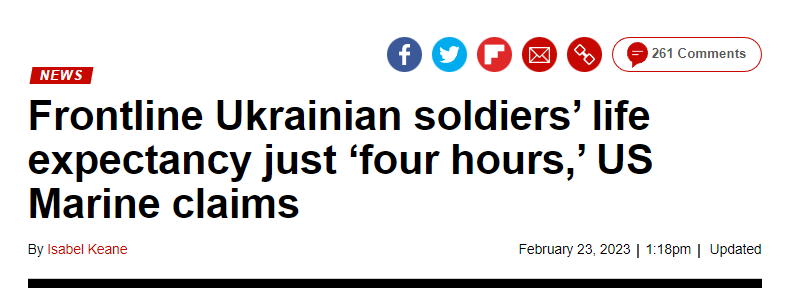



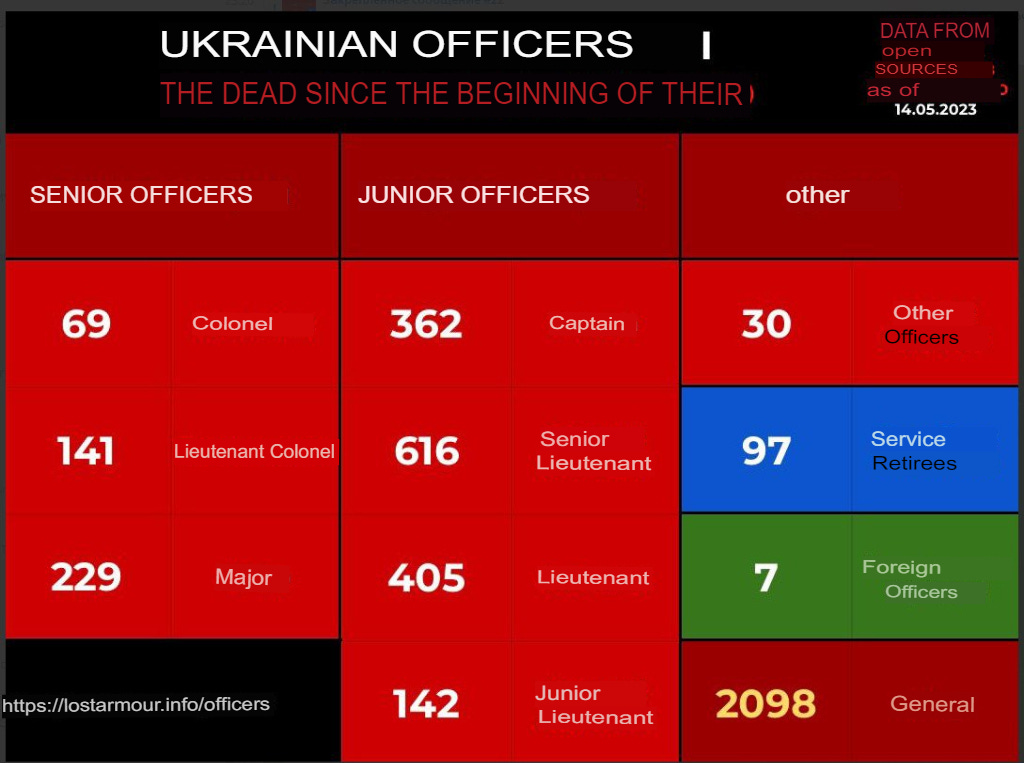
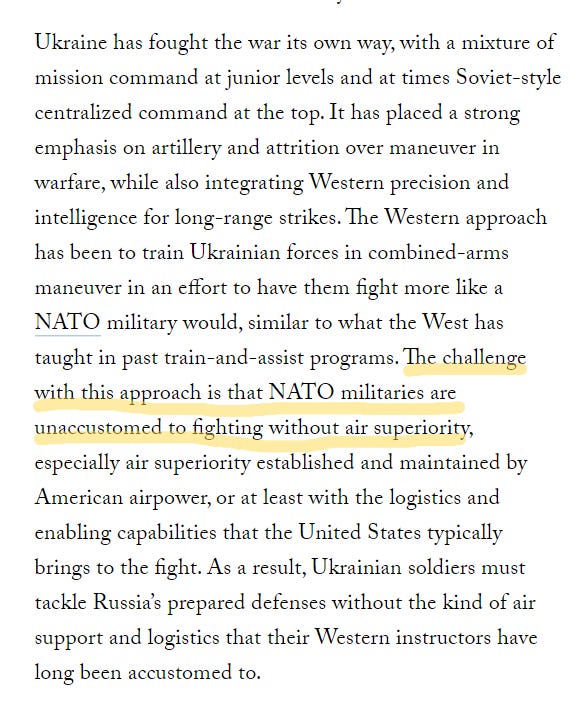


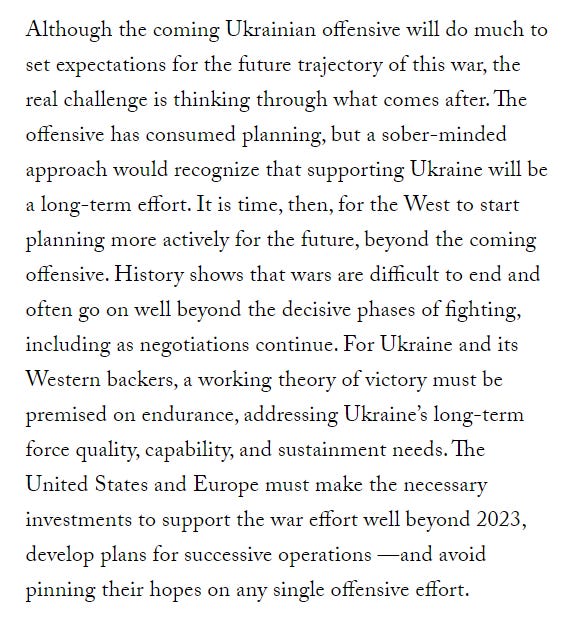

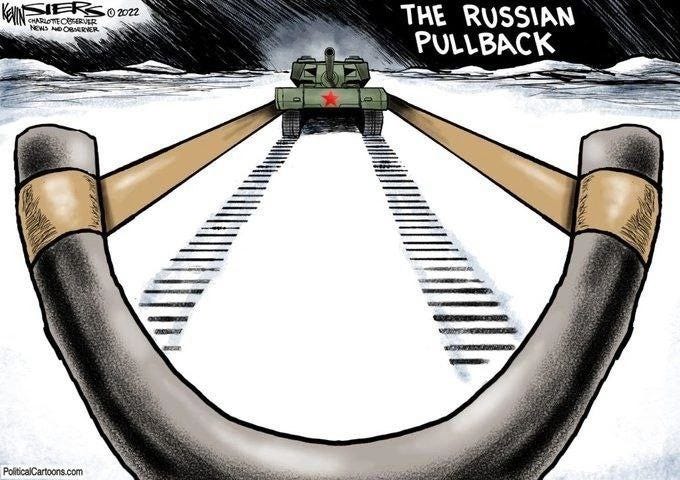
One thing about Russia's increased production that appears to have passed people by is that all those extra shifts etc will mean an increased number of Russians with experience of industrial manufacturing jobs, machining etc. This increase in human capital will have a future flow on effect to the industrial economy regardless of the outcome of the war, and is in marked contrast to the decrease in human capital caused by the West's off-shoring over the past two decades.
Great article, Simplicius, as usual for you. Thank you for your hard work! Please keep it up. However, there is a "typo" in the first sentence. I really think you must have meant "clown princes"